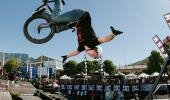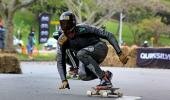Words: Candice van Niekerk ǀ Photos: Various Photographers | Videos: AvJstudio & Rosanna Scott
So what is roller derby? Well, it’s probably the most awesome sport that you will hear of. Roller derby is a full contact women’s sport played on quad skates. It's more than skating around in circles; it requires endurance and strength, as well as strategy. It is also an exhilarating sport to watch and will keep you on the edge of your seat.
Photo credit: Jethro Snyders
Looking back
In the 1920s, 'roller derby' was used to describe endurance races on quad skates. By the 1930s, it became a transcontinental sport, which had evolved from a skating race on a banked track to more of a physical competition that involved over-emphasized collisions and falls. The sport became very popular in the 1960s, but was shut down in 1973 when its popularity petered out. There were a few attempts to bring roller derby back over the years, especially in the 1980s, but to no avail.
Roller derby, as we know it today, was started in the early 2000s in Austin, Texas. A flat track roller derby, as opposed to a banked track that was previously used, was created because it was easier and cheaper to mark down a track on a flat piece of floor. Today, there are more than 1,200 flat track roller derby leagues around the world, of which four can be found in South Africa.
The C-Max Roller Derby League, in Johannesburg, was founded by Melinda Lotz and myself in June 2010 and was the first-ever roller derby league in South Africa. Since then, the sport has grown in popularity and can be found all over the country, with leagues also established in Cape Town, Durban and Pretoria.
Playing the game
The objective of the game is to lap opposing skaters and score as many points as possible for your own team. For example, one opposing player passed equals one point scored. The game is played on a flat, oval track and with two teams, of which there are a maximum of 14 skaters in each team.
A roller derby 'bout' (competition) consists of two 30-minute periods of roller skating around the rink. Each period is then divided into two-minute 'jams'; this is when a pack of ‘blockers’ try and prevent the opposing team’s ‘jammer’ from breaking through the pack and scoring points. The first jammer legally through the pack is awarded lead jammer status and can end a jam before the two minutes is up. The team with the most points wins.
Teams will field five skaters for a jam; three blockers, one pivot (demarcated by a stripe across their helmet) and one jammer (demarcated by a star on their helmet). The blockers and pivots form one large pack on the track. The jammer's job is to try and pass through the pack and score points by legally passing players from the opposing team (on their second pass onwards). The pack will play offense and defense simultaneously, to both assist their own jammer to get through and prevent the opposition jammer from scoring points. The jammer scores a point for every opposing blocker she passes and if she is lucky, she can score a grand slam point for lapping the opposing jammer.
Knowing the rules
There are lots of rules in roller derby and breaking them means a one-minute stint in the Sin Bin, or penalty box as it is otherwise known.
Here is a list of some of the most common penalties you will see in a bout:
• BACK BLOCK: Pushing or shoving to the back of a player, which causes them to fall or lose position.
• ELBOWS: The use of elbows, which causes an opponent to fall or lose position.
• LOW BLOCK: Tripping a skater and making them fall or lose position.
• TRACK CUT: Skating out of bounds (off track) and re-entering in front of another player to better your position.
• FOREARM: The use of the forearm in a block, which causes an opponent to fall or lose position.
• HIGH BLOCK: A block that makes contact above the shoulders.
• STOP BLOCK: A skater engages an opponent whilst stationary on the track.
• DIRECTION OF GAME PLAY: A skater engages an opponent whilst skating in a clockwise direction (game play must move in an anti-clockwise direction. Skaters may skate in the opposite direction as long as they do not make contact with an opposing skater).
Photo credit: Darling Harbour Photography
Going derby style
Due to the fact that this is a full contact sport, there is compulsory gear that must be worn. Derby girls are required to wear quad skates (no roller blades), wrist guards, elbow guards, knee guards, helmets, gum guards and sometimes even butt padding.
Roller derby costumes, known as 'boutfits' are also a big thing at bouts. Hot pants, fishnet stockings and war paint are some of the most popular choices among the players. Yes, we wear make-up and then sweat it off.
Now roller derby is not just about fancy gear, it's also about the players skating under pseudonyms or derby names. There is even an international roster where players register their derby names, to ensure that it is unique to them. Some examples of the C-Max derby girls’ names are Slam-u-well Jackson, Sookie Smackhouse, Klap Cake and Faye Tality.
Getting tough
C-Max's five home teams (Hate City, Raging Warmones, Thundering Hellcats, Savage Sailor Dolls and Slam Damsels) compete regularly against each other in Johannesburg, whilst our All Star Travel Team will soon be competing against other teams in South Africa and around the world. The home season kicks off in April 2014, and we would love to have you there, so keep an eye out for dates on our website or Facebook page.
Team South Africa will be competing in the Blood & Thunder 2014 Roller Derby World Cup for the very first time, which is being held in Dallas, Texas in December. The first set of team tryouts have already been held in Durban, Johannesburg and Cape Town, and they were tough and sweaty. After six gruelling hours, the top girls came out strong and will be attending the next round of tryouts in June this year. The final team selection will be judged by representatives from Cape Town, Johannesburg, Durban and we are currently liaising with the Texas Roller Girls (the number-two team in the world) to see if they will also help out with the judging. The final team roster will be announced in September and will consist of up to 20 skaters.
Joining in
We are always looking for more derby girls, referees, sponsors and anyone who would like to be a part of the sport in some way. So if you are over the age of 18 you are welcome to join, just make sure you are wearing your big-girl panties. Men are also welcome to join, as we are currently trying to start up a men’s team and always looking for more male referees.
So if you're up to trying something different and having some fun, then why not give roller derby a go? I hope to see you on the track, soon.
More information
For more information about women’s flat track roller derby or the rules, visit www.wftda.com
If you would like to find out more about:
* C-Max Roller Derby League, Johannesburg, visit www.cmaxrollerderby.com or Facebook: C-Max Roller Derby League
* Cape Town Roller Girls, visit www.capetownrollergirls.com or Facebook: Cape Town Rollergirls
* Durban Derby, visit Facebook: Durban Derby
C-Max (Jhb) has recently started a recreational league that is held every Sunday afternoon at the Peace Street Sports Complex in Modderfontein from 14h00 to 17h00. Entrance is just R20. At these sessions you will be taught all the basics, starting from how to stay upright on your own eight wheels.









